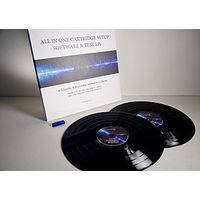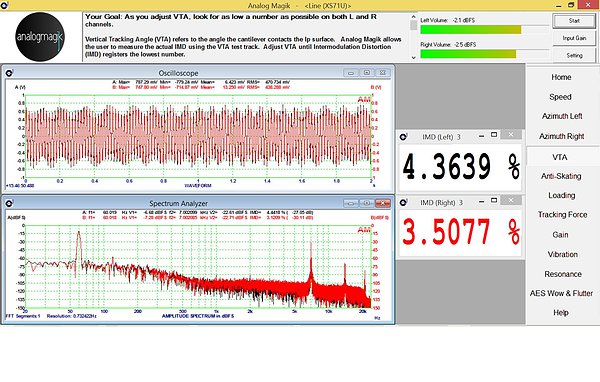First look at the AnalogMagik cartridge setup toolkit
Author: Brian Date Posted:11 March 2018

A Scientific & Repeatable Method To Calibrate: Speed, Wow & Flutter, Azimuth, VTA, VTF, Anti-skating, Loading, Gain, Vibrations & Resonance Frequencies.
My first impression when I went to the website of AnalogMagik was skepticism, and when I saw the price of the package I doubted its saleability. But, I am a turntable specialist, and so any tools that enhance my ability to set up a turntable accurately are worth having a look at. So I signed up to be a dealer.
The second impression when I received the kits was that it was too complicated. The kit itself just consists of 33 and 45 LPs, a sheet with the serial number, and a dongle (USB key) without which the software will not run. When I read the instructions online I found that the software only works with Windows PCs, and they were recommending that you use a particular external sound card and have a dedicated laptop PC. Both of these add to the expense of the process. At that stage I thought it was unlikely many enthusiasts would be prepared to purchase the kit, however I thought it might be a service I could offer, or it might be something that I could hire out.
I happen to have a laptop that’s about 5 years old and isn’t being used much because it is too slow, so I had intended to reformat it anyway. I did that, loaded Windows 10, then registered one of the kits and downloaded and installed the AnalogMagik software. I didn’t have the recommended sound card, but purchased an inexpensive Asus one to see if I could get the kit working.
I didn’t encounter any problems in setting up the PC and connecting the sound card to the output from my phono preamp. I ran the program and was presented with the screen shown below.

The graphs on the left were initially blank. Down the right side of the screen is a list of the different tests that can be performed, in this screenshot VTA has been selected. At the top are the instructions relating to this test. The bars on the top right show the signal level being received for each channel. The main graphs show the waveform of the signal received and an analysis of the different frequencies included, and the large numbers are the measure of Intermodulation Distortion for each channel.
I started with something easy, the Speed. Using a SpeedStrobe I had previously adjusted the speed of my Origin Live Calypso turntable to 33 1/3 RPM. The instructions for this test advise that track 3 on side A of the 33 LP has a 3150Hz signal recorded, and if the turntable’s speed is correct that is what you should measure. As the track played the measured frequency displayed varied between 3.134 and 3.136 KHz so that was reassuring although I don’t know why there was variation. The speed was sampled every 4 seconds and also I noticed that only the left channel had a signal. I also ran this test with the 45 LP and adjusted the trim pot to get the speed exactly correct. I then ran the Wow & Flutter test and moved the motor pod till I achieved the lowest reading.
Next I tried the VTA, as in the screen shot above. The Origin Live Encounter tonearm I use allows for precise height changes of fractions of a millimetre. Changing the height in each direction a half mm at a time I was able to find a position which gave the lowest reading of IMD, although not as low as in the screenshot above. The final position was not much different to what I had set up manually by making the tonearm parallel to the record when playing, but it was interesting to be able to actually measure the difference even a half mm in height made. The top bars showed the signal from the two channels only varied by 0.3dB which was also reassuring.
Following the sequence of tutorials on the AnalogMagik website the Azimuth tests were next. As the tonearm I am using is not adjustable I was unable to make any adjustments but the crosstalk readings were very similar anyway. I went on to the anti-skating test, which was very useful as it showed I had it set too low.
The tracking force setting was next, and as that also affects VTA I knew I would have to go back to VTA afterwards. I found this test a bit perplexing as I was getting less than 2% Total Harmonic Distortion (THD) with the 7KHz track and about 7% on the 300Hz track. The instructions suggest varying the tracking force until the two sets are similar, but I couldn’t find a VTF that reduced that difference. There is a disclaimer for this test that says “measurement is limited by equipment quality and vibrations, not all cartridges will yield meaningful results.”
The Loading test is only valid when you have a phono stage with adjustable loading. This seems like a very useful test but the Icon Audio PS1.2 valve phono stage I was using is not adjustable. I’ll try this test later on a different phono stage.
The Gain test is only useful for phono stages that have adjustable gain. In this case I was able to adjust the output level from the PS1.2 to achieve the best signal to noise ratio.
The resonance test revealed that the Encounter tonearm and Seto-Hori cartridge were just within the recommended 8Hz - 12Hz range.
The Vibration test produced a startling result. The instructions said a IMD measurement of 1.5 - 3% should be possible, but my initial readings were up in the 10 - 15% range. The suggestion was to experiment with vibration absorption so I put Vibrapods under the turntable’s feet and saw an immediate reduction to 5 - 7%. With that success I will do more experiments.
So in conclusion.
This toolkit is a very useful suite of tests that will help anyone get better performance from their vinyl front end. I will offer to perform these tests on turntables I service. They also provide an objective method of measuring performance characteristics of different turntables. The end result that we are looking for, however, is improved musical performance. And in that respect I can confirm that I have never heard my turntable sound better with the current cartridge. In fact the improvement seemed greater with 45s LPs although I didn’t actually do any of the tests except Speed with the 45 version of the test LPs. The greater sense of transparency, where the sound seems to emerge from the space between and behind the LS3/5a speakers rather than from them is the most noticeable difference. I’ve been setting up turntables since the mid 70s, and I think I’m pretty good at it, but I have to admit this toolkit enables me to a better job.
